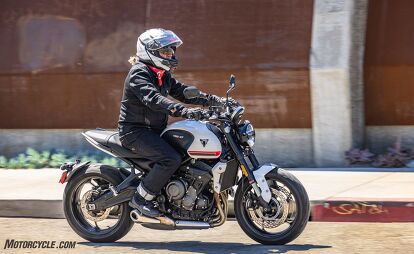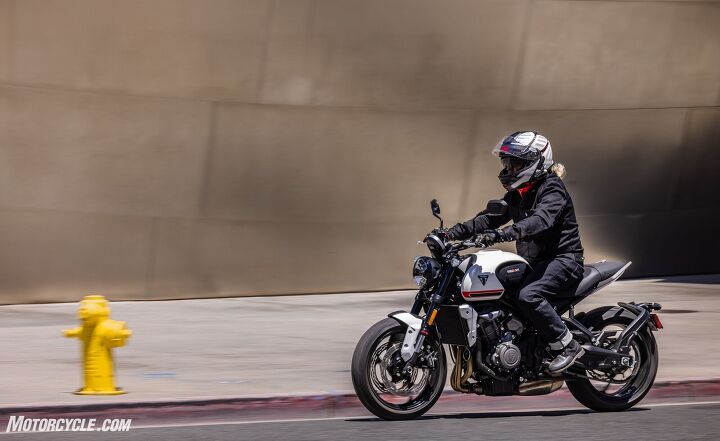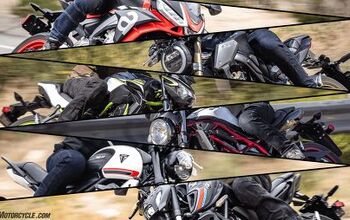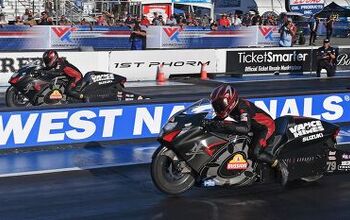2021 Triumph Trident Review - First Ride
Triumph's shot in the $8k middleweight naked bike wars is a direct hit
Another cool deal about getting old is you’re allowed to forget things, which can be really convenient. In the present case, I knew there was a new Triumph Trident for 2021, but I didn’t really remember any of the details when I hopped on it in Ryan Adams’ driveway one morning. Immediately, it felt really light and small, a lot like the Ducati Monster we just reviewed last month. And what size is the 3-cylinder engine in this one? It definitely feels revvier than the one in the Tiger 850 GT we rode a couple months ago, but not much slower at all…
2021 Triumph Trident
| Engine | 18.5/20 |
| Suspension/Handling | 13.0/15 |
| Transmission/Clutch | 8.5/10 |
| Brakes | 8.0/10 |
| Instruments/Controls | 4.5/5 |
| Ergonomics/Comfort | 9.0/10 |
| Appearance/Quality | 8.5/10 |
| Desirability | 8.5/10 |
| Value | 9.5/10 |
| Overall Score | 88/100 |
I was kind of surprised to learn the thing’s only 660cc when I sat down to investigate. And though the Trident bears a few marks of being an “entry-level” motorcycle, I was also surprised to read $8,095. The first Street Twin, of which I was a big fan back in 2016, sold for $8700, and has now crept up to $9400. That makes this new Trident the least expensive Triumph you can buy, by a lot – but it really doesn’t ride that way.
And just like the new Ducati Monster we rode last month, Triumph gave it the most expensive ingredient: light weight. The Trident weighs 417 pounds wet to the Street Twin’s 476, says Triumph; the MO scales have it at 427. (Ducati claims lopping 40 lbs off the new Monster got it down to 414.)
Everything You Want To Know About 2021 Triumph Trident (Except What It’s Like To Ride)
Just like the new Monster, that lightness makes the bike accessible to more riders. Unlike the $12k Monster, this Triumph wants to fit into that rich, naked middleweight niche occupied by the Yamaha MT-07, SV650, et al. It’s only $400 more than the MT, which is another great motorcycle the Trident reminds you of a lot. Both share short wheelbases a smidge over 55 inches, with Yamaha weighing 21 lbs less than the Trident. That little bit of extra mass seems to somehow give a bit more gravitas and sophistication to the Triumph; it’s the one you’d pick to take the Queen for a ride on back.
New 660 Triple
In the engine compartment, the new Trident is packing a powerplant that outguns its direct competitors. Its new 660 cc triple is a resized, retuned version of the beloved 675 cc unit from the Street Triple, which began life in 2007. The new engine uses the same 74mm bore as the old 675, but swings its pistons through 51.1mm strokes instead of 52.3mm ones.
Triumph says there are 67 new engine components compared to the Street Triple, including a new crankshaft, alternator, camshaft, cylinder head, cylinder liners, throttle bodies and airbox, along with an exhaust, header, and silencer. Triumph rates it at 80 horsepower at 10,250 rpm and 47 lb-ft of torque at 6,250 rpm, and says this short-stroke Triple has more bottom-end torque than the Street Triple S, with 90% of its torque available as low as 3,600 rpm.
Luckily, we had the MotoGP Werks dyno standing by to confirm. At the rear wheel, our fresh Trident spat out 72 hp at 10,300 (right at the rev limiter, strangely…), and 42.8 lb-ft at 6400 rpm. Quick, what’s 90% of 42.8? It’s 38.5, and the little Triple is already producing that much torque at 3200 rpm. It’s the same formula Triumph used to great success in that first Street Twin, which wasn’t all that powerful, but was terribly torquey right off idle and through the midrange. Not only is that the best kind of power for novices, it’s the best kind of power for everybody on the street, where there sadly just aren’t many long, full-throttle straights. It makes it easy to put the hurt on the cars when the light turns green (look both ways), pass trucks, blast out of corners – and it perfectly complements the Trident’s lack of weight. The Trident makes a bunch more power up top than that first Street Twin, weighs a lot less, and is cheaper too. Progress.
New Frame too
Instead of the Street Trip’s aluminum perimeter frame, Triumph followed the class orthodoxy in building a simple steel tube affair and swingarm, with strategically placed plastic modesty panels on either side to cover up whatever ugliness might exist where the main tubes meet the swingarm pivot and (welded on) subframe. It’s got to be way less expensive than the Street Triple’s complex aluminum frame, and probably every bit as effective for a fun, everyday street motorcycle. If it was flexing, I never noticed. In fact the headstock is gusseted with steel plates, and with 4.2 inches of trail – a bit more than the new Monster and the MT-07 – the Trident always felt perfectly stable running through serial bumps, and over 100 mph on the freeway – a speed at which it feels like there’s quite a bit more to be had.
The bad news is there’s quite a bit of tingle coming through the grips at 6000 rpm and 80 mph. The good news is it goes away below 75, and above about 85 indicated. With a snug jacket and a good helmet, the Trident could be a fine high-speed personal commuter.
Speaking of orthodoxy, the no-adjust 41mm inverted Showa fork out front works fine under my ever-expanding girth – just like the 43mm one on the new Monster did. Most bikes in this class have non-inverted forks. The preload-adjustable only Showa shock, mounted in linkage out back, kept up its end fine also, even in its softest preload setting. Only the big potholes and bumps bottom things out. Triumph never seems to let a motorcycle leave its works without dialled suspension, and the Trident, as we say, is no exception. No doubt the premium Michelin Road 5 tires it wears as standard equipment help in the ride and handling department, too.
Ergos
Again with the new Monster comparison: Just like it, Triumph made the Trident nice and thin between the thighs and gave it a relatively plush seat, which makes it more comfortable for everybody as well as more accessible to short people.
The 31.7-inch seat height isn’t really tall (my 30-inch legs can almost flatfoot it on both sides), but that narrowness makes it feel shorter. And the 3.7-gallon plastic fuel tank has nice cutouts that don’t bodyshame your thighs. That narrowness extends down to the sporty aluminum footpegs, and reinforces the bike’s skinny spunkiness.
The tapered aluminum handlebar places the grips right where they should be on a naked bike if you’re 5’8″. The front brake lever is adjustable; the clutch lever is not, but the slip/assist clutch makes the lever easy to disengage. There’s also a lot of steering sweep that makes tight turns easy.
Whip in top cog, etc…
In any cog, including first, power feeds in smoothly from idle with no jerkiness or flat spots and segues instantly into that fat midrange plateau which doesn’t care if you downshift or not when you whack the throttle. No surprises, just more acceleration than you’d expect from 660 cc, along with the award-winning sounds a high-revving Triple produces. On the street, I’ve always been a fan of mid-size engines just because you get to wind them out a lot more than a big engine and feel the noise. Especially mid-size engines like this one, which makes lots of midrange but is also happy to bounce off the rev limiter when the occasion calls for it.
There’s no quickshifter on here, though it is available as an accessory. The six-speed gearbox works fine without it, and I actually enjoyed blipping a throttle again for downshifts, after all the quickshifter-equipped bikes we’ve been riding lately.
The Trident is ride-by-wire, with Rain and Road modes. There’s no IMU here, so traction control and ABS are programmed into those two modes. Traction control you can disable independently; ABS stays on. Squeezing the front brake almost hard enough to scare myself, I never felt the ABS cycle on in Road mode. The rear you can definitely feel coming on early and often, but really only when you’re provoking it on purpose, trying to leave your mark on the world, and failing.
Those two 310mm discs seem to have more than enough power along with good feel, even if the slide-type two-piston Nissin calipers aren’t the latest thing in braking hardware. Light weight strikes again; there’s less motorcycle to stop.
Digital
The kids need to stay connected, so the Trident gets a nice enough TFT display with all the usual functions, and busting out for the My Triumph Connectivity System accessory module will also summon up turn-by-turn navigation, GoPro control, phone and music control via Bluetooth – all using the left switchgear.
Some corners were cut…
But none that matter, far as we can tell. Braking hardware is mostly of `90s vintage, but on a 427-lb motorcycle with 72 horsepower, it all works perfectly fine. Ditto for the “base” Showa suspension. As this class of motorcycle has boomed, Showa and KYB, and even Marzocchi (who makes the Tiger 850 GT stuff) seem to have all stepped up their game. Lean sensitive ABS and TC? No gots. For a city bike, I mainly want ABS for when cars turn left in front of me, and TC on a 43-lb-ft motorcycle only when it’s wet. Cruise control? No. With it, though, I would be happy to travel on this bike.
It’s the lack of all that that keeps the price down, and furthermore, Triumph says this will be its least expensive motorcycle to own, too. After the 600-mile break-in service, you’re good to go until 10,000 miles, and valve clearances don’t need checking until 20k miles. For those who don’t have access to a nice workspace, that’s a big deal.
Details…
LED lighting is standard, and the Trident sports a very nice level of detailing for an $8k bike. Your magnetic tank bag won’t stick to the plastic fuel tank, but that’s more than offset by the fact there’s no ugly tank seam along the bottom edge, and the front fender takes up the theme and protects the fork sliders.
The paint on our Crystal White bike is impeccable, with a nice pearlescent sheen to it even. Tasteful Triumph identifying marks, with just a hint of Union Jack, abound. At the end of the day, I’m forced to once again come off like a complete paid shill for a new Triumph. So why not let’s quote an actual one? Steve Sargent is Triumph’s Chief Product Officer:
“What we wanted with the new Trident 660 was to give the riders in this really exciting middleweight roadster world all of the things they want from their bike, with a genuine set of real advantages that set a new benchmark for choice. From the competitive price, to the triple power and performance, plus the benefits of class-leading handling and technology, we believe the Trident 660 is a real milestone in the category, and introduces the Triumph brand and the advantages of a triple engine to a whole new generation of riders across the world.”
I wouldn’t say he’s wrong at all, but we’ll be the judge of that won’t we? Stay tuned for a massive MO middleweight naked comparison in a couple of weeks time.
2021 Triumph Trident
+ Highs
- Inexpensive but not cheap
- Torquey triple is just right
- Light weight, transparent ergonomics
– Sighs
- Cruise would’ve been nice…
- Vintage brakes work like modern ones
- A bit buzzy at 80 mph
In Gear

Helmet: Shoei Neotec 2 Splicer $799
Jacket: Sa1nt Unbreakable Denim $500
Gloves: Dainese 4-Stroke $249
Jeans: Sa1nt Unbreakable $250
Boots: Sidi Arcadia Tex $179
2021 Triumph Trident Specifications | |
|---|---|
| MSRP | $8,095 |
| Engine Type | 660 cc liquid-cooled inline three-cylinder, DOHC, four valves per cylinder |
| Bore and Stroke | 74mm x 51.1mm |
| Compression Ratio | 11.95:1 |
| Horsepower (measured, rear wheel) | 72.3 hp @ 10,300 rpm |
| Torque | 42.8 lb-ft @ 6400 rpm |
| Transmission | 6-speed, slip/assist clutch |
| Final Drive | Chain |
| Front Suspension | 41mm inverted Showa separate function fork |
| Rear Suspension | one Showa shock, adjustable for spring preload |
| Front Brake | Dual 310mm discs, Nissin 2-piston slide-type calipers, ABS |
| Rear Brake | 255mm disc, 1-piston slide-type Nissin caliper, ABS |
| Front Tire | 120/70 – R17 |
| Rear Tire | 180/55 – R17 |
| Rake/Trail | 24.6 deg/ 4.22 in (107.3mm) |
| Wheelbase | 55.2 in. (1401mm) |
| Seat Height | 31.7 in. (805mm) |
| Curb Weight (MO scales) | 427 lbs. (194 kg) |
| Fuel Capacity | 3.7 US gal. |
| Colors | Silver Ice/Diablo Red, Matt Jet Black/Matt Silver Ice, Crystal White, Sapphire Black |
| Warranty | 2 years unlimited-mileage |
More by John Burns























































































Comments
Join the conversation
I see where they saved money by eliminating the rear of the bike. Other then that it seems like a winner.
I dare you to strap something to that padded spike called a passenger seat. I also dare you to ride it to work on a wet street. The Missenden Flyer is the only reviewer that rode the bike on a wet road and it covered him and the bike with grime thrown off the rear tire. Shame on today's motorcycle journalists for ignoring the obvious.